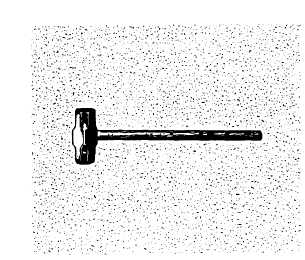by blazing. Files and stones are usual items of
equipment for sharpening the edges of tools.
Hubs, stakes, pipe, and other driven markers
are often driven with the driving peen of a hatchet
or a single-bit ax. A sledgehammer, however, is
a more suitable tool for the purpose. A double-
faced, long-handled sledgehammer is shown in
figure 11-33. It is swung with both hands. There
are also short-handled sledgehammers, swung
with one hand. A sledgehammer is classified
according to the weight of the head; common
weights are 6, 8, 10, 12, 14, and 16 lb. The 8- and
10-lb weights are most commonly used.
When the ground is too compact or too frozen
to permit wooden stakes and hubs to be driven
directly, the way for a stake or hub is opened by
first driving in a heavy, conical-pointed steel bar,
10 to 16 in. long, called a bull-point. One of the
heavy steel form pins, used to pin down side forms
for concrete paving, can be used as a bull-point;
however, the pyramidal pavement-breaker bit on
a jack hammer (pneumatic hammer used to drive
paving breaker bits, stone drills, and the like)
makes a better bull-point. Because a jack hammer
bit is made of high-carbon steel, it is liable
to chip and mushroom when subjected to heavy
pounding. Do not use a bull-point with a badly
damaged head; it should be refinished by grinding
or cutting off before being used to avoid injury
to personnel.
In searching for hidden markers, you may
need a shovel like the one shown in figure 11-34
for clearing top cover by careful digging. In soft
ground, such as loose, sandy soil, you may prefer
to use a square-pointed shovel or a probing steel
rod to locate buried markers.
Figure 11-33.-A double-faced sledgehammer.
Figure 11-34.-Long-handled shovel.
A pick (fig. 11-35) may be required to chip
bituminous pavement off of manhole covers and
for levering up covers. Sometimes a crowbar is
needed for levering manhole covers.
Buried metal markers may be located with the
help of a magnetic device called a dip needle or
a battery-powered instrument, similar in principle
to a mine detector, commonly called a pipe finder.
These instruments are used in engineering surveys
to locate utility pipelines, buried manhole and
valve box covers, and the like. These instruments
can generally be borrowed from the utilities
division of the public works department (PWD)
of the larger shore stations.
SURVEYING TAPES
Tapes are used in surveying to measure
horizontal, vertical, and slope distances. They
may be made of a ribbon or a band of steel, an
alloy of steel, cloth reinforced with metal, or
synthetic materials. Tapes are issued in various
lengths and widths and graduated in a variety of
ways.
Metallic Tapes
A metallic tape is made of high-grade synthetic
material with strong metallic. strands (bronze-
brass-copper wire) woven in the warped face of
the tape and coated with a tough plastic for
Figure 11-35.-Pick.
11-36






